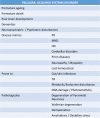Meat and Nicotinamide: A Causal Role in Human Evolution, History, and Demographics
- PMID: 28579800
- PMCID: PMC5417583
- DOI: 10.1177/1178646917704661
Meat and Nicotinamide: A Causal Role in Human Evolution, History, and Demographics
Abstract
Hunting for meat was a critical step in all animal and human evolution. A key brain-trophic element in meat is vitamin B3 / nicotinamide. The supply of meat and nicotinamide steadily increased from the Cambrian origin of animal predators ratcheting ever larger brains. This culminated in the 3-million-year evolution of Homo sapiens and our overall demographic success. We view human evolution, recent history, and agricultural and demographic transitions in the light of meat and nicotinamide intake. A biochemical and immunological switch is highlighted that affects fertility in the 'de novo' tryptophan-to-kynurenine-nicotinamide 'immune tolerance' pathway. Longevity relates to nicotinamide adenine dinucleotide consumer pathways. High meat intake correlates with moderate fertility, high intelligence, good health, and longevity with consequent population stability, whereas low meat/high cereal intake (short of starvation) correlates with high fertility, disease, and population booms and busts. Too high a meat intake and fertility falls below replacement levels. Reducing variances in meat consumption might help stabilise population growth and improve human capital.
Keywords: Malthus; Meat; NAD(H); evolution; fertility; immunological tolerance; longevity; nicotinamide; vitamin B3.
Conflict of interest statement
DECLARATION OF CONFLICTING INTERESTS: The author(s) declared no potential conflicts of interest with respect to the research, authorship, and/or publication of this article.
Figures





















References
-
- Clutton-Brock T. Mammal Societies. Hoboken, NJ: Wiley; 2016.
-
- Mayhew RJ. Malthus. Cambridge, MA: Harvard University Press; 2014.
-
- Morowitz HJ. Energy Flow in Biology: Biological Organization as a Problem in Thermal Physics. Woodbridge, CT: Ox Bow Press; 1979.
Publication types
LinkOut - more resources
Full Text Sources
Other Literature Sources

